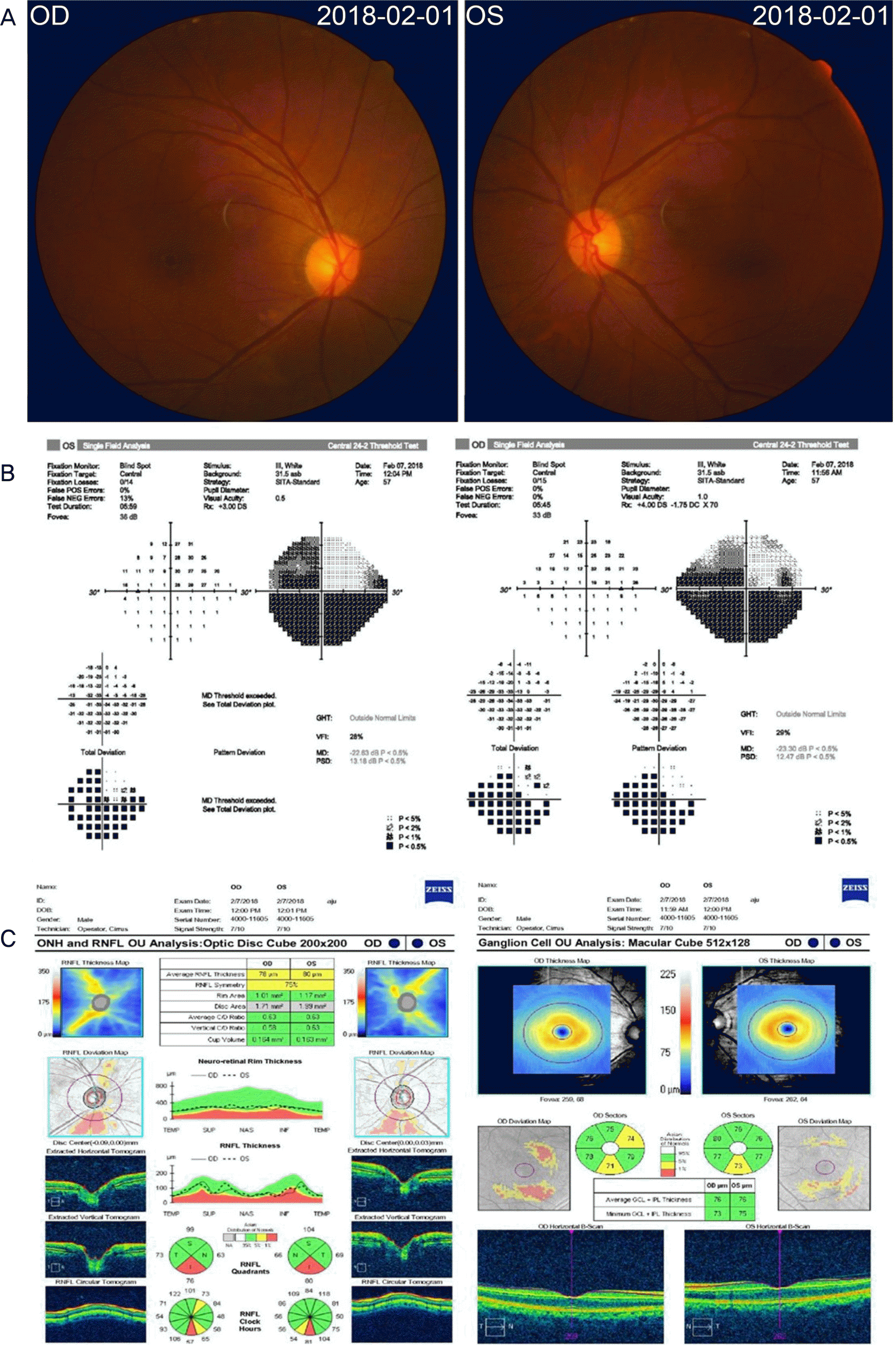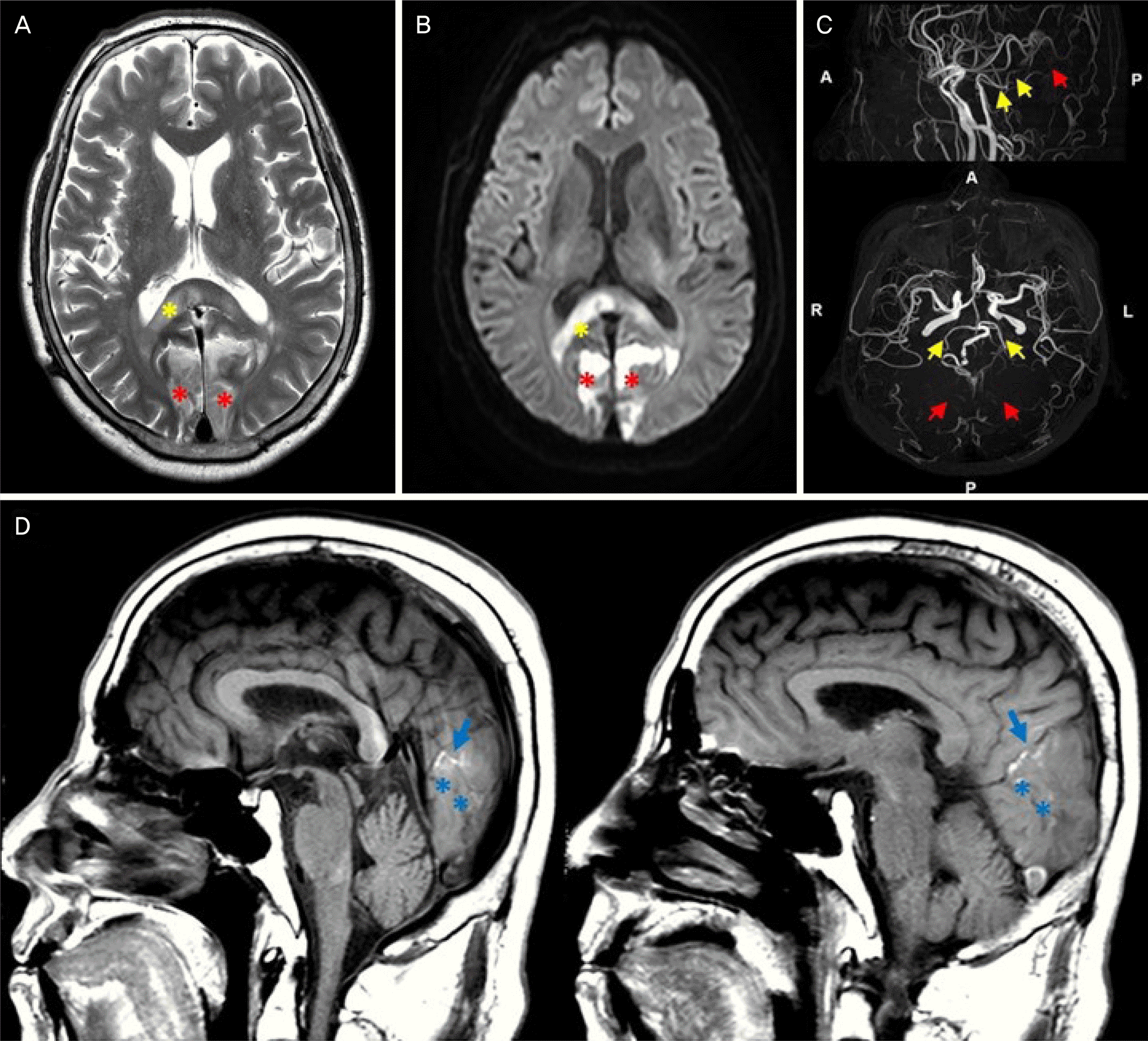Abstract
Purpose
Horizontal visual field defects are generally caused by lesions before the optic chiasm, but we report a case with bilateral inferior altitudinal defects secondary to bilateral occipital lobe infarction.
Case summary
A 57-year-old male with a history of diabetes and hypertension presented with a month of blurring in the inferior visual field. His corrected visual acuity was 1.0 in the right eye and 0.63 in the left eye, and the intraocular pressure was normal in each eye. Pupillary response, ocular movement, and color vision tests were normal in both eyes. There was no specific finding of the optic disc and macula on fundus examination. Visual field examination revealed an inferior congruous homonymous hemianopia with horizontal meridian sparing and a left incongruous homonymous quadrantanopia. Optical coherence tomography for peripapillary retinal nerve fiber layer thickness revealed a mild decrease in the inferior disc of both eyes. Brain magnetic resonance imaging confirmed the presence of an acute infarction confined with upper medial calcarine fissures of bilateral occipital lobe and the right splenium of the corpus callosum, which were consistent with inferior altitudinal hemianopia and left superior incongruous quadrantanopia, respectively. Brain magnetic resonance angiography showed multiple stenosis of bilateral posterior cerebral arteries.
Go to : 
References
1. Choi J. Visual pathway disorders. Jang BL, editor. Neuro-abdominal. 3rd ed.Seoul: Ilchokak;2017. chap. 3.
2. Kline LB. Visual fields. Kline LB, Bajandas FJ, editors. Neuroophthalmology review manual. 6th ed.Thorofare: SLACK Inc.;2008. chap.1.
3. Shin KY, Kyung SE. Analysis of visual field defect in patient with brain lesion. J Korean Ophthalmol Soc. 2015; 56:1439–45.

4. Holt LJ, Anderson SF. Bilateral occipital lobe stroke with inferior altitudinal defects. Optometry. 2000; 71:690–702.
5. Luu ST, Lee AW, Chen CS. Bilateral occipital lobe infarction with altitudinal field loss following radiofrequency cardiac catheter ablation. BMC Cardiovasc Disord. 2010; 10:14.

6. Newman RP, Kinkel WR, Jacobs L. Altitudinal hemianopia caused by occipital infarctions. Clinical and computerized tomographic correlations. Arch Neurol. 1984; 41:413–8.
7. Vanroose E, Marchau M, Dehaene I, Lammens M. Altitudinal hemianopia; a clinical and anatomical entity or a mere co-incidence? Case report and review of literature. Acta Neurol Belg. 1990; 90:254–64.
8. Kim BB, Shyn KH. Temporary amaurosis with persistent visual field defect following acute blood loss. Korean J Ophthalmol. 1995; 9:47–50.

9. Barnett HMJ, Mohr JP, Stein BM, Yatsu FM. Stroke: abdominal, diagnosis and management. 2nd ed.New York: Churchill Livingstone;1992. p. 419–42.
Go to : 
 | Figure 1.Ocular findings including fundus photography, visual field test, and optical coherence tomography (OCT). (A) Fundus photographs show normal disc and retina in both eyes. (B) Humphrey 24–2 visual field examination demonstrates bilateral inferior altitudinal defects associated with left superior incongruous quadrantanopia. (C) OCT for retinal nerve fiber layer thickness does not correspond to the results of visual field test. OD = oculus dexter; OS = oculus sinister; ONH = optic nerve head; RNFL = retinal nerve fiber layer; OU = oculus unitas. |
 | Figure 2.Brain magnetic resonance imaging (MRI) showing bilateral occipital lobe infarction and brain magnetic resonance angiography (MRA) showing stenosis of bilateral posterior cerebral artery (PCA). (A) T2-weighted axial MRI and (B) Diffusion-weighted imaging show acute infarctions in bilateral occipital lobe (red asterisks) and right splenium of corpus callosum (yellow asterisk). (C) Sagittal and axial MRA show multifocal stenosis of bilateral PCA (yellow arrows) and not visualized distal portion of PCA (red arrows). (D) T1-weighted sagittal MRI shows the occipital infarctions (blue arrows) above the calcarine sulcus (blue asterisks). A = anterior; P = posterior; R = right; L = left. |




 PDF
PDF ePub
ePub Citation
Citation Print
Print


 XML Download
XML Download